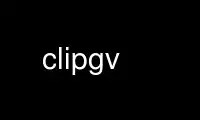
This is the command clipgv that can be run in the OnWorks free hosting provider using one of our multiple free online workstations such as Ubuntu Online, Fedora Online, Windows online emulator or MAC OS online emulator
PROGRAM:
NAME
clip - Clip an OOGL object against planes or other surfaces
SYNOPSIS
clip [-v axisx,y,z,...]
[-g value-or-point] [-l value-or-point]
[-s nstrips[,fraction]] [-e]
[-sph centerx,y,z,...] [-cyl centerx,y,z,...]
[ooglfile]
DESCRIPTION
Clip, adapted from Daeron Meyer's ginsu module, allows clipping an OOGL object against
planes, spheres, or cylinders from the UNIX command line. Its input can come from a file
or standard input; output is written to standard output.
Options specify a function of space position; the output is the portion of the object
where the function is greater or less than some given value, or the portion lying between
two values. Alternatively, an object can be sliced into equally-spaced strips. Objects
may be of any dimension (but see the BUGS section).
Options are:
-g value-or-point
-l value-or-point
Select the portion of the object where the function is greater than (-g) or less
than (-l) the given value. If both are specified, the result is the portion of the
object satisfying both conditions.
If, rather than a single number, the argument to -l or -g is a point (a series of
x,y,z,... values separated by commas, with no embedded blanks), then the clipping
surface is one chosen to pass through that point.
-v axisx,y,z,...
Specifies a direction in space. For planar clipping (the default), it's the plane
normal direction; the clipping function is the inner product between the direction
vector and the point on the object. For cylindrical clipping, -v specifies the
direction of the cylinder's axis; the clipping function is the distance from the
axis.
-sph centerx,y,z,...
Clip against spheres centered on x,y,z,.... The clipping function is the distance
from the given center. Coordinates must be separated by commas without intervening
spaces.
-cyl centerx,y,z,...
Clip against cylinders with an axis passing through centerx,y,z,..., with axis
direction given by the -v option. The clipping function is the distance from the
axis.
-s nslices[,fraction]
Clip an object into a series of nslices ribbons spanning its entire extent -- the
range of function-values over the object. Part of each ribbon is omitted; the
fraction, default .5, sets the width of the visible part of a ribbon compared to
the ribbon period. There are a total of (nslices+fraction-1) ribbon periods across
the object, so e.g. -s 2,.5 slices the object into equal thirds, omitting the
middle third. The output OOGL object is a LIST of OFFs, one per ribbon.
-e Don't emit a clipped OOGL object, just print two numbers, listing the minimum and
maximum function values for the object. If -g or -l clipping options are
specified, the object is clipped before determining the function range. If none of
the object remains, clip prints "0 0".
EXAMPLES
To extract the portion of an object lying below the x+y+z=1 plane:
clip -l 1 -v 1,1,1 file.oogl > portion.oogl
To extract the portion of an object lying in the positive octant and below the x+y+z=1
plane, we can pipe multiple instances of clip together to find the intersection of several
half-spaces:
clip -g 0 -v 1,0,0 file.oogl | \
clip -g 0 -v 0,1,0 | \
clip -g 0 -v 0,0,1 | \
clip -l 1 -v 1,1,1 > portion.oogl
To find the region lying between two surfaces (either above one and below the other, or
below the first and above the second), say the planes 2x + y -.5z = 1 and y + 2z = 0:
echo "{ LIST"
clip -v 2,1,-.5 -g 1 file.oogl | clip -v 0,1,2 -l 0
clip -v 2,1,-.5 -l 1 file.oogl | clip -v 0,1,2 -g 0
echo "}"
We use pipelines to compute intersections, and a LIST to form their union.
Use clipgv online using onworks.net services
